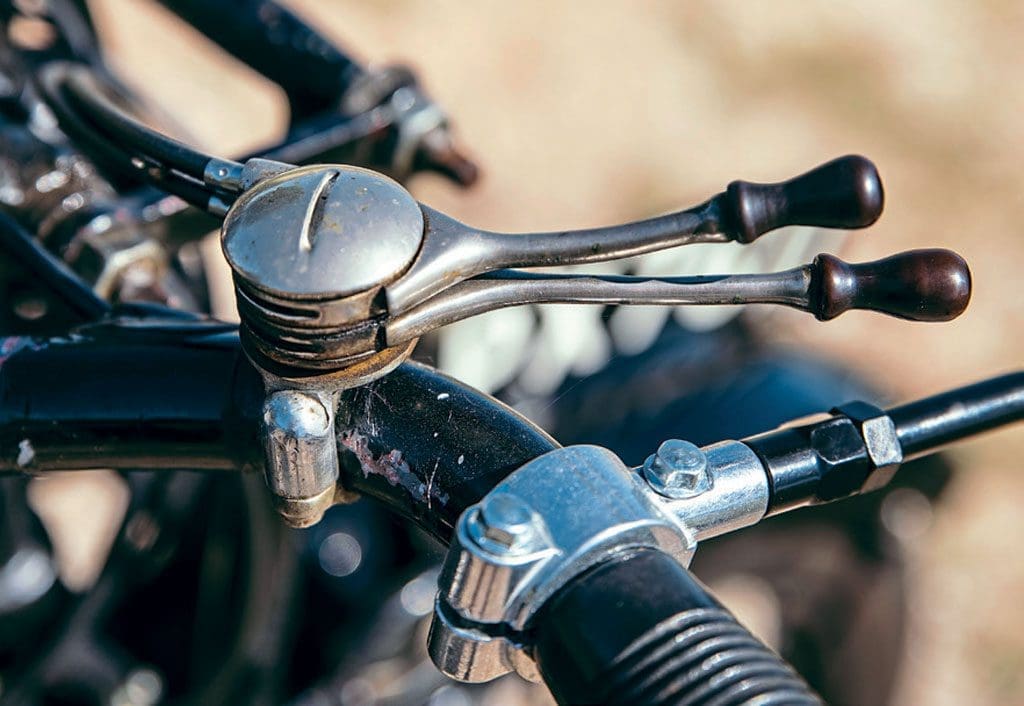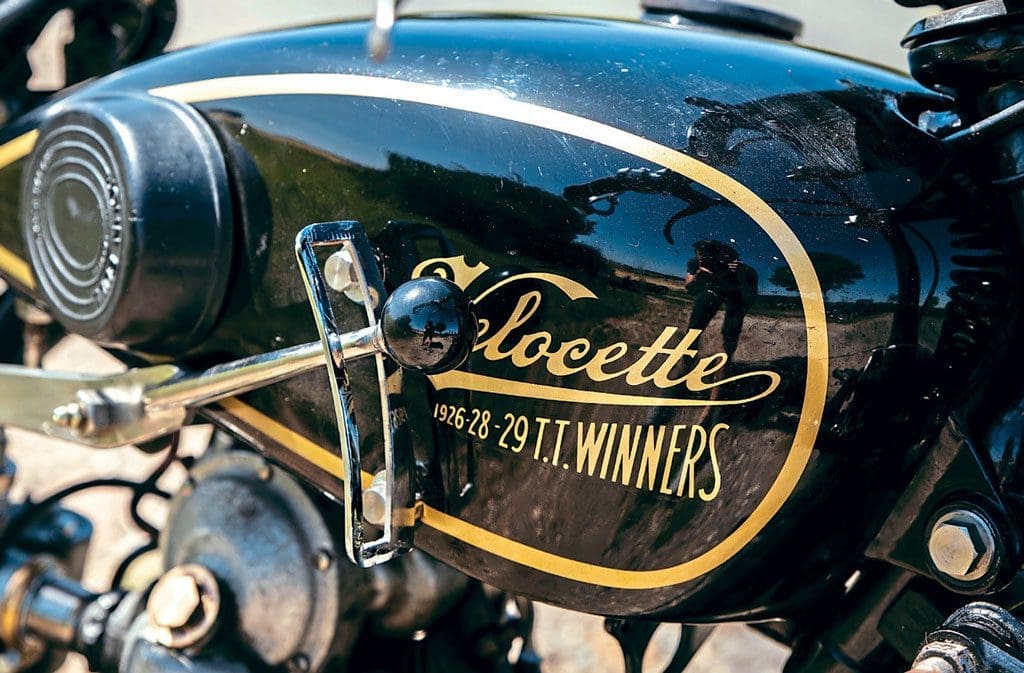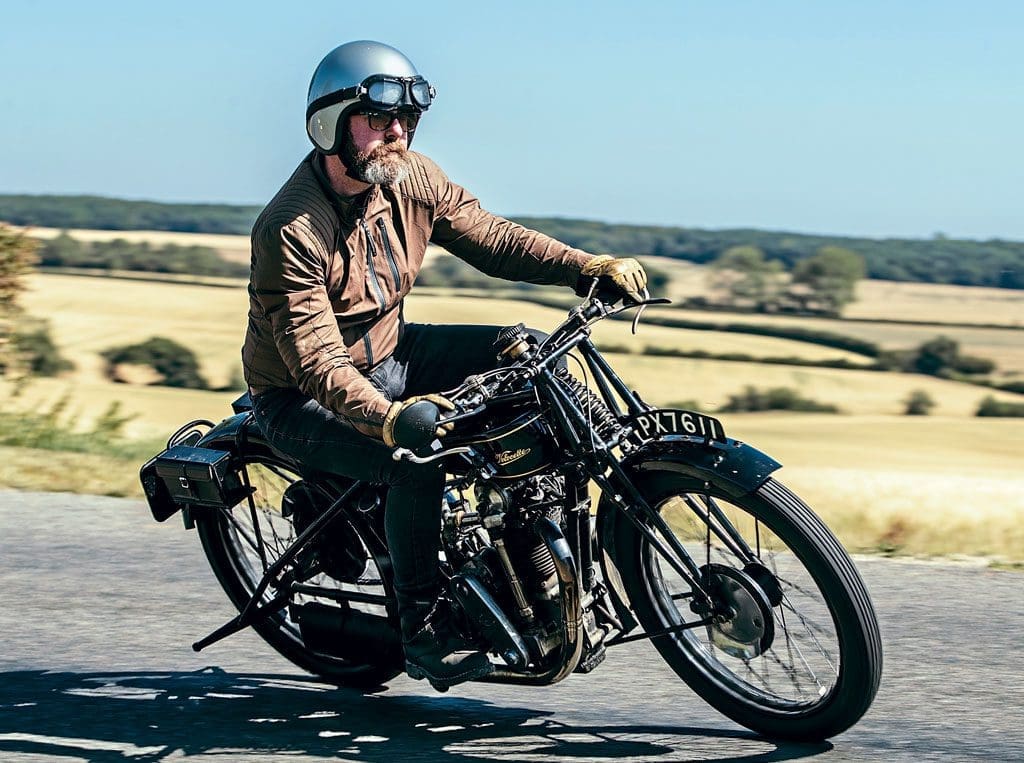Words: James Robinson | Photographs: Gary Chapman
With an overhead camshaft engine and fully circulating oil system, plus sparkling performance, the first generation ‘cammy’ Velocettes certainly make a case.
The story goes, that when 1920s road racing superstar and multi TT winner Alec Bennett first sampled a mark one overhead camshaft (OHC) 350cc Velocette, so convinced was he that it’d win the 348cc Junior TT, he eschewed a fee from Veloce… unless he was victorious.
The shrewd Bennett, naturally, knew what he was doing and duly triumphed in the 1926 Junior; though, actually, the model had debuted at the previous year’s races, where although it showed promise, results weren’t what the factory would’ve hoped for, as factory tester Fred Povey and Gus Kuhn both retired.
In 1926, the same duo were Bennett’s back-up; Kuhn was fifth (averaging over 62mph, against Bennett’s 66.7mph) with Povey ninth. It was impressive stuff. On the back of such high-profile triumphs, then, of course, demand for the sophisticated, modern Velocette proved high.
The bevel-driven overhead camshaft engine was designed in 1923 by Percy Goodman – the Goodman family were owners of Veloce Limited – and was a huge departure from the mainly two-strokes that the company had made up until then.
The new machine, the Model K, featured beaded-edge tyres and Druid side spring forks in its debut season, as well as a fully circulating oil-system, though the prototypes had been total loss, and was priced at £65; machines (badged ‘Veloce’) were delivered to customers mid-1925.
The name soon changed to the more-familiar Velocette and in September the KSS (Super Sport) joined the range, with higher-compression piston and slimmer mudguards.
For 1926, Webb forks replaced the Druids on all camshaft models, while wired on tyres weren’t long coming, either. By 1927, the 348cc overhead camshaft Velocette could justifiably claim to be among the most sophisticated motorcycles on the market and the company was producing around 50 OHC machines a week.

Model K
Owner Rob Drury recounts thinking in October 2016, when he first took delivery of his 1927 Model K: “That’ll not want much doing to it.”
As Rob recalls: “It was clear that the tyres would need to be replaced and I expected to do those tasks that are necessary to the safe recommissioning of a machine that has not been used in several years.
“First job was to remove the wheels for the new tyres to be fitted. The wheels were in good condition but were chrome plated with painted centres.
“Steve Lomas (Five-One Wheels) suggested painting the whole wheels black and then replacing the spoke nipples with nickel plated ones to replicate how the wheels looked when they were new. This produced a splendid result with a ribbed 21in tyre fitted to the front and a front ‘trailie’ 21in tyre, reversed, fitted to the rear.
“When the brake plates were removed from the hubs, it was clear that the shoes needed relining. They were dispatched to Classic Brake Services where Ian fitted oversized linings and machined them to drum size for optimum contact.
“There was no spark from the magneto, so the round ML was taken off and sent to Dave Lindsley for a full overhaul.
“In order to run the engine and check it out, a BTH KDI magneto was fitted until the ML was returned. The engine started easily and ran sweetly with good oil pressure but would not keep running at low revs.”
That prompted Rob setting to on a list which grew… and grew… to quite exhaustive proportions. On the list was the Amac TT carburettor – though ultrasonically cleaned, Rob decided in the interests of usability, to replace it with a new Amal 276.
Other jobs included a new engine shock absorber, new cables and chains all round, he moved and refitted the oil-tank, restored the rear mudguard, bought new toolboxes, made a new rear brake rod, various new bolts, studs and nuts. He was then ready to start using it.
“Once I started to get used to the lever throttle and hand change [this was Rob’s first so-equipped motorcycle] my overall impression was that it’s superb. It’s lively but also tractable.”
Other jobs have included refitting the original, refurbished ML while the Oldham couplings in the vertical shaft drive were also replaced. And having had a bit of use from the machine, and enthused, Rob investing more time and effort; new valves springs and collets went in, as well as new tappets to the rockers. More use threw up a few more issues.
As Rob explains: “By the end of 2017, the only substantial part of the bike that had not received attention was the bottom end of the engine, so I decided to do that during the winter.
“The engine was stripped and the previously overhauled top end stood to one side. As the cylinder barrel was removed, it was clear that the big end was very worn. I hadn’t suspected this because there was no mechanical noise. The big end was replaced, and the flywheels were fitted with new roller bearings on both main shafts.
“The crankcases were machined to allow an oil seal to be fitted to the main shaft bevel. Then the engine was reassembled with a new lower bevel housing to replace the badly worn original.”
By May 2018, ‘PX 7611’ was ready to once more return to the road; after another season’s riding, now smitten with it, Rob decided to tidy things up cosmetically that winter.
“I decided to have the fuel tank repainted, lined and transferred and the exhaust pipe replated with nickel, and bought a new silencer.
“Work on the tank commenced by stripping the paint to reveal the condition. It was dire, a very poor replica beyond repair. I started to lay out a new tank but was offered an Indian made replica. It nearly fitted, but the mountings were different.
“A new base was made, with an additional reserve fuel tap and a breather. It was painted by Clive White at Rapier Paintwork in Hull, who did a splendid job. The painted tank lifts the general appearance of the bike too.”
By the summer of 2019, PX was in regular use. There were a few further niggles to iron out.
“The gearchange gate didn’t have any ‘stops’, merely indents which were easy to slip past. Peter Miles [a fellow early cammy owner] kindly made me a gate to the correct pattern and the gearchange now works without fault.
“The clutch lever was an oddity without a slot to engage the cable and nipple, it meant that one cable nipple had to be soldered after being connected to the lever. Changing a cable would be a major operation, so I bought a new standard solid lever and was then able to fit a standard clutch cable.
“In November 2019, the new tank gate, the gear linkage and the fuel filler cap were removed and taken to Prestige Electroplaters to be nickel plated. The parts were collected in late January 2020, fitted and are the cherry on the cake.”
Rob is also now in touch with a previous owner of PX, so more history and details may come to light, too.

KSS
Now Rob had the Model K and was thoroughly enjoying it, he was enthused about road-going Mk. I cammies.
“Jim Plant [well-known Velocette enthusiast] told me of a Mk.I KSS that was likely to be offered for sale and sent me some photographs. The bike was the property of a widow who now wished to sell it. I agreed to the asking price and collected it in October 2019.”
On first inspection, the KSS looked clean and tidy, and though fitted with a three-speed gearbox, it came with a four-speed item too, which set Rob thinking… The result being that he refurbished and fitted the four-speeder (with a set of Venom gears installed to replace the wider ratio originals) and figured out his own, ‘positive stop’ hand-change.
“I tried out the original hand-change mechanism with the four-speed ’box. Though it was possible to change gear, it was all badly worn, so I designed and made a new one.
“The tank gate no longer needed the dog-leg slot, so was milled out parallel. The front portion of the gear lever is a round section with a spherical knob; the whole linkage looks well and performs nicely. It’s a slightly whimsical thing to do instead of using a foot-change, but I feel that it’s more in keeping with the bike.”
He also had a damaged gearbox end cover, with the mounting for the foot-change broken, which lent itself ideally to the hand-change conversion.
On acquisition, Rob had done some research too: “A file of documents accompanied the bike and provided an interesting insight into the work that had been done by the previous owner, and a bit of history.
“When he [the previous owner] obtained it from the Bristol area, it had an A-suffix registration and correspondence showed that he had traced some of the bike’s origins and obtained an age related number, 279 XUU.
“It was of interest to me that the bike had been owned in the 1950s by Harry Oglesby of Beverley, father of my similarly named friend who still lives in the town. Harry [junior] told me that his father had three similar machines that he rode on the road and racetrack, all with the same registration.
“Things got swapped about and that is presumably where the engine was united with its current frame. Scratched inside the timing cover, it’s recorded that the engine was rebuilt by ‘H Oglesby, 1954’.
“With the bike on the bench, as a way of familiarising myself with it, I started to do small repairs. I noticed both the clutch and brake levers were worn at their pivots.
“The pivot screws were in good order, so the holes in the clamps were bushed to remove the play and they were fitted onto new black, KTT-pattern handlebars. The front brake cable didn’t have the correct adjuster in the front fork lug, so a new cable was made and fitted.
“I applied a grease gun to the front forks and they appeared to have been well maintained.
“The petrol filler cap spring cleats were rusty and stiff but after a liberal dose of oil and with a new seal fitted, the cap was fit for purpose.” There was a bit more work too…
“In preparation for fitting the four-speed gearbox, the oil tank was drained and removed, as was the redundant battery platform. The chainguard and primary chaincases were removed. The primary drive was dismantled and all parts were in good condition and correctly assembled.
“The rear chainguard tail section was designed to engage positively with the sprocket cover (it also had a redundant bracket that originally attached it to the mudguard valance). The bracket was removed and a proper interface for the rear section made and welded in place. The tail section had the proper rear fixing boss made and fitted.
“The primary chaincase outer had redundant studs for the dynamo belt covers. These holes were welded up and a drain plug fitting welded in. The absence of dynamo belt covers left the engine shock absorber exposed, so a detachable cover was made for the purposes of safety and keeping dirt out. All of the repaired sheet metal parts and the new cover were painted by Rapier Paintwork.
“For reasons of style and performance, I wanted a longer inlet tract but the standard oil tank is too close to allow this. I had intended to fit an oval oil tank but the battery platform mounting bracket on the seat tube precluded that.
“A new oil tank was made to utilise the space between the rear mudguard and the seat tube. There was a tap in the old tank but I have fitted a ball valve assembly into the feed pipe to the engine.
“The carburettor was worn and replaced with a new clip fitting Amal 276 carburettor, along with the slightly longer induction tract. The magneto has been checked and has a fine blue spark.”
As the KSS had been standing for several years, Rob changed the tyres, despite the fact they looked brand-new.
“I noticed that the brake shoes have been professionally relined and turned to size but there was movement at the front brake anchor which was taken up by fixing a thick shim to the brake plate.”
Finishing touches included a new silencer a bottle-type one as the 1931 ‘short fishtail’ is unavailable, and then, in March 2020, and after all new fluids, and having been spun on rollers to circulate some oil, the KSS struck up, for the first time in at least six years.
It sounded healthy immediately and oil pressure was good. A short run up the street on March 28 was as much of a test ride as circumstances would allow.
As lockdown restrictions eased, so Rob was able to put some miles on the KSS. A few minor niggles appeared – a weep from the timing cover among them – but that aside, the KSS has proved itself a capable and reliable performer.

Chalk and cheese
So the two we have before us are just basically the same, right? Wrong. They feel different, although the family resemblance is also clear too.
Having been fortunate to have ridden several versions of Mk.I ‘cammies’, up to and including the last of the Mk.IV KTTs which, in many ways, are the last of the Mk.Is, from a chassis perspective, they all, each and every one, are unquestionably related.
Short and squat, these are not particularly ‘relaxing’ machines to ride, as certain vintage machines unquestionably are.
On an early Velo, there’s a slight twitchiness throughout, they feel a bit flighty and feisty and encourage a sporting riding demeanour; compared to a contemporary Norton or Sunbeam, say, they seem much more racy, decidedly quicker steering, the short – or at least short-feeling – wheelbase being where the sensation comes from.
A Mk. I wheelbase is given as 53¾in, as opposed to 55in for a Mk.II (see the box out regarding Mk.I and Mk.II); that surprised me, it feels a much greater difference.
Of the two, I set off on the K first, with Rob on the KSS, with photographer Gary leading the way in his car, me following. I had no problem whatsoever keeping up with the car and A-road traffic, the K simply loping along. It really does want to get going, with gear ratios ideally spaced for ‘progressing at pace.’
Rob was on the KSS and I noticed he was dropping back; when we swapped over, I realised why, as the KSS seems to be much shorter geared than the K, its engine working much harder on busier roads than the K.
With me following Rob, I could feel the KSS engine was really buzzing to keep up with the K, which simply eased away, its engine working much less strenuously.
Conversely, once on the narrow backroads and lanes we favour for much of our riding, the four-speed KSS is the more suitable tool. The positive stop, hand-change gearbox works brilliantly. One simply pulls back to engage first gear, the lever returning to its central location, then it’s push forward for second, again for third, again for fourth.
When faced with an unexpected hill having rounded a corner – the bane of the hand-change rider’s life – it’s possible to really quickly snatch down a gear, much more so than with the usual gated arrangement. Although a little more momentum is lost than if a foot-change was employed, the effect is less than with a traditional hand-change. It’s superb.
There’s a lever throttle on the K, with a twist-grip on the KSS, which, again, suits the manner that each gearbox/gearchange operates.
After we’d completed photographic duties, Rob and I went for a delightful ride in the rolling Lincolnshire Wolds, the hills echoing to the bouncing note of the two same-but-different, complementary cammy singles.
It is perhaps ironic that the older of the pair would be the better choice for high-speed, modern-day rides, where it’d keep up with modern traffic on all but dual-carriageways and motorways.
The KSS would be the one to select for single track lanes and short, sharp hills, much fun to be had slipping down a gear and powering up inclines.
For a more relaxing, pottering experience one would choose a Mk.II (Rob has one of them too) with the Mk.Is more the preserve of those with a sporting mindset, with this pair offering two intriguing variations on the same – excellent and great fun – theme.




